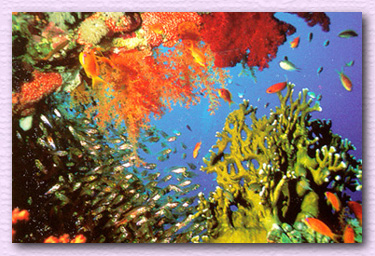 |
Coral Reefs And Climate Change
Coral reefs are very sensitive to slight changes in water temperature and light intensity levels making them the best barometers of global warming. And life is heating up on coral reefs!
 |
Currently reef-building corals are
living close to their upper thermal
limit and become stressed by higher than
normal light intensities that cause
coral bleaching. Elevated ocean
temperatures of as little as 2.7 degrees
F. (1.5 degrees C) over the average
summer temperature destroy the symbiotic
algae resident in corals. This causes
the coral animal to become transparent,
revealing the white limestone coral
skeleton beneath, hence the term "coral
bleaching." This causes corals to die in
great numbers if conditions do not
return to normal. The worst coral
bleaching event on record occurred in
1998, which saw the complete loss of
live coral from some reefs around the
world. This is best explained as a
result of global climate warming,
according to many experts.
According to our records, the worst
bleaching event in the Keys occurred in
1997. Images from Craig Quirolo's
Photomonitoring Survey can be found on
the website in the section entitled
Coral Stress and Disease. Recently
published scientific information on the
subject is available on our web-site in
the Science Section (www.reefrelief.org).
The recent paper released by Greenpeace
entitled Climate Change, Coral Bleaching
and the Future of the World's Coral
Reefs by Ove Hoegh-Guldberg, Associate
Professor, School of Biological
Sciences, University of Sydney concluded
that:
1. Coral bleaching is due to warmer than
normal temperatures causing
zooxanthellae to become supersensitive
to light;
2. Increased sea temperature is the
primary reason for why coral bleaching
has occurred with increasing intensity
and frequency over the past two decades.
3. Mass coral bleaching began to occur in 1980 due to the steady rise in sea temperatures that have pushed reef-building corals closer to their thermal maxima. El Nino events (warmer than normal years) push corals above their maxima and cause bleaching to occur.
4. Corals do not appear to be showing
any signs that they are able to
acclimate or adapt fast enough to keep
pace with these changes in sea
temperature.
5. Coral bleaching events are projected to steadily increase in frequency and intensity until they occur every year by 2030-2070 if greenhouse gases emissions continue to rise unabated.
6. Some regions, (e.g. Caribbean Sea and
Southeast Asia) are expected to
experience the effects of climate change
on their reefs sooner than other areas
(e.g. Central Pacific).
This is very alarming for those of us
who live around and care for coral
reefs. The direct links between coral
reefs and climate change have been the
subject of another document from the
World Wildlife Fund Climate Change
Campaign. America's Global Warming
Solutions (Bernow et al 1999) reports
that if the United States were to reduce
its annual carbon dioxide emissions by
about 654 metric tons of carbon by 2010,
the result would be a net economic
savings, almost 900,000 net additional
jobs and significant decreases in
pollutant emissions that damage the
environment and are harmful to human
health, especially of children and
elderly. See
www.worldwildlife.org/climate.
Even tourism affects the climate,
especially air travel, the fastest
growing source of greenhouse gas
emissions according to Tourism: facing
the challenge of climate change,
compiled by World Wildlife Fund from a
report by David Viner and Maureen Agnew
of the Climatic Research Unit,
University of East Anglia, Norwich, U.K.
Numbers are forecast to leap from 594
million international travelers in 1996
to 702 million by next year, 1018
million by 2010 and 1600 million in
2020.
We should be making our best efforts to
stop polluting our atmosphere. This is a
huge project, both on a large-scale
through governments and international
companies and on a small-scale through
our own personal efforts. Beginning on a
personal level, we can all do our part
by reducing our use of fossil fuels
(that means getting out the bicycle or
walking instead of driving or
car-pooling or using public
transportation, if available; by
recycling; and by cutting down on our
use of plastics.
For more info: www.reefrelief.org.